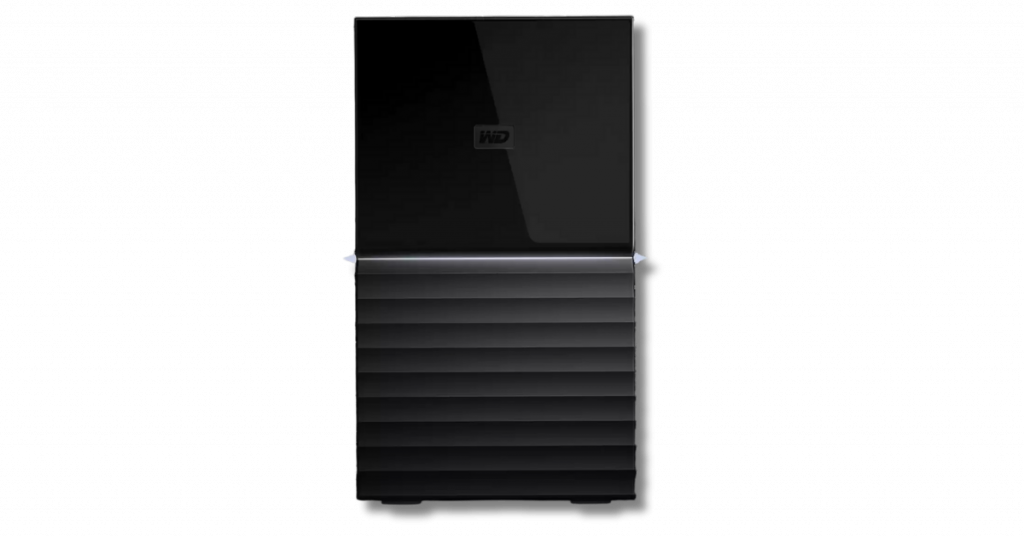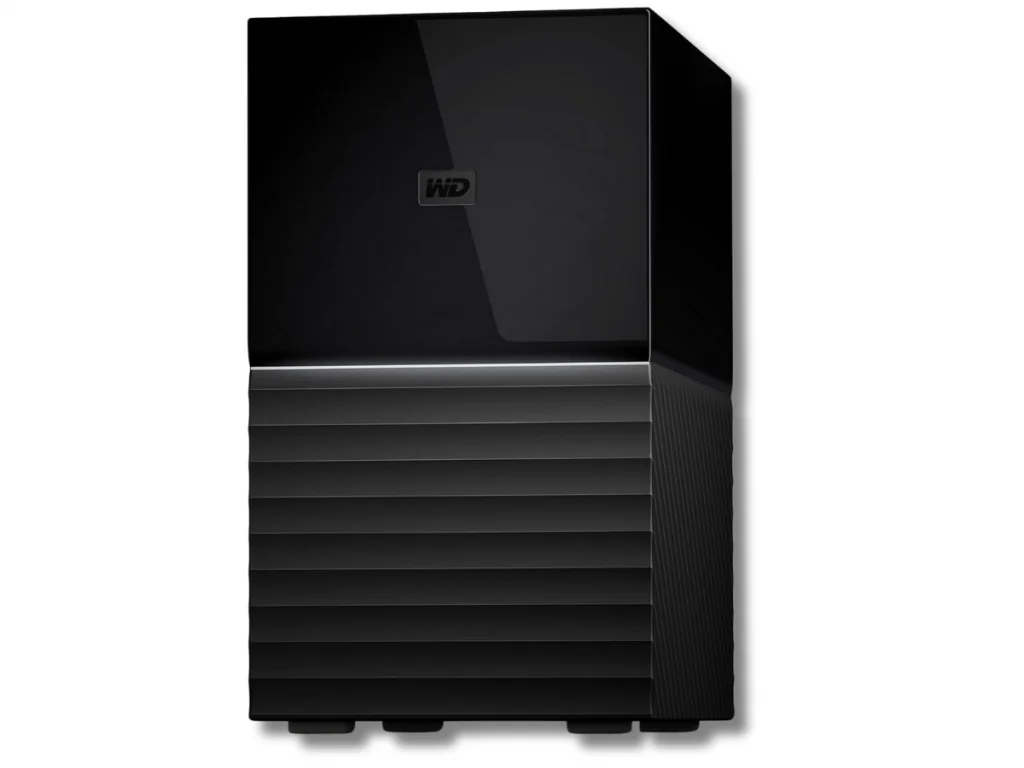Case Overview
A medical products supplier in Florida faced a serious outage when a WD My Book Duo RAID 0 (8 TB) failed without warning. The unit held thousands of customer records and operational files used day to day.
When the failure hit, the business lost access to all data, bringing internal workflows to a standstill.
Both disks in the RAID 0 set presented as unreadable at the same time. Because RAID 0 prioritises throughput over redundancy, a single disk fault can cause total loss of access. A dual-disk malfunction compounds the risk and makes recovery more complex, demanding specialist handling.
Recognising the risk of irreversible loss, the client engaged RAID Recovery Services to manage the WD My Book Duo data recovery under controlled laboratory procedures.

Initial Symptoms and User Attempts
The incident began when the WD My Book Duo was no longer recognised by the host computer. The status light stayed on, but the volume did not appear in File Explorer.
Both disks spun up normally, which initially pointed to a software or logical fault rather than a total hardware failure.
Concerned, the client worked through Western Digital’s support guidance: checking USB cabling, updating firmware, and using WD Drive Utilities to attempt an array rebuild. Despite these steps, the system remained inaccessible and the disks continued to present as uninitialised.
Repeated attempts to repair or rebuild increased the risk of overwriting recoverable data. This is one of the common NAS data loss causes we see when users try to rectify complex RAID failures without professional support.
Decision to Contact RAID Recovery Services
After the DIY attempts failed, the client acknowledged the risk of further damage and researched RAID 0 specialists. Few providers demonstrated clear expertise with WD My Book Duo devices, so they selected RAID Recovery Services for confidentiality and technical proficiency.
During the consultation, our team reviewed the symptoms and prior steps, then set out a recovery plan. To simplify logistics, we issued a prepaid shipping label. Once the unit arrived, our engineers initiated diagnostics to confirm the fault profile and establish recovery potential.
Diagnostic Findings
On arrival at our recovery lab, engineers performed a full hardware and logical assessment of the WD My Book Duo RAID 0. Both disks were physically sound, with no signs of head damage or other mechanical faults.
The problem was logical. The array’s structure was heavily corrupted, so the host system could not recognise the volume.
During evaluation we identified contributing factors:
Corrupted RAID metadata disrupting the array configuration
Bad sectors on both disks affecting critical data blocks
Damaged partition tables rendering the volume unmountable

Recovery Procedure
After confirming the logical corruption, our engineers executed a controlled process designed to protect data integrity at every stage.
We began by creating sector by sector images of both disks using specialised hardware imagers. Imaging first ensured analysis could proceed from exact replicas, avoiding additional wear on the originals and preventing any inadvertent changes.
With clean images secured, we analysed the RAID parameters in detail, including stripe size, disk order, and the starting offset.
Using these verified values, the RAID 0 set was reconstructed in a secure virtual environment, allowing us to rebuild the original data layout without modifying the client’s source media.
Once the virtual array was in place, we performed targeted extraction with advanced utilities to retrieve directories and file fragments from the reconstructed set.
Every item recovered was verified for internal consistency and cross checked against logical references to ensure accuracy.
Attempting to rebuild a RAID outside this controlled workflow can overwrite valid data and reduce recoverability.
For more detail, see our guide on how to repair degraded RAID arrays safely.

Verification and Results
After extraction, all recovered files were organised and validated through multiple checks. Our engineers compared the restored data against the client’s known directory structure to confirm completeness and integrity.
No major file corruption or gaps were identified, indicating a successful outcome. The final dataset included customer records, financial reports, and internal documentation critical to day to day operations.
Once validation was complete, the data was written to an encrypted external drive and prepared for secure return. Within a few days, the Florida supplier received the media, confirmed that files were accessible and functional, and resumed operations immediately.
This result demonstrates the effectiveness of a controlled WD My Book Duo data recovery process, from imaging and virtual reconstruction to verified handback.
Fast turnaround times for business-critical data
Client Outcome and Feedback
The client expressed strong appreciation for the efficiency and transparency of the recovery process. From the initial consultation through to final delivery, our team maintained consistent communication and provided clear updates at every stage.
The supplier noted that the experience was smoother and faster than expected for a RAID 0 case with two unreadable disks.
They were particularly impressed by the secure handling procedures and the detail provided during post recovery verification. The client confirmed that all critical business records were fully restored and that no data loss occurred.
By engaging RAID Recovery Services rather than continuing DIY efforts, the Florida medical supplier avoided permanent loss and recovered the files needed to support day to day operations and customer relationships. This outcome underscores the value of a controlled WD My Book Duo data recovery process.
Key Takeaways
This case underlines how quickly data loss can escalate in RAID 0 systems and why immediate professional support is critical. With no redundancy in RAID 0, a fault on a single disk can render the entire array inaccessible.
In this instance, the client’s decision to stop DIY recovery and engage specialists was pivotal to achieving a full restoration.
Key lessons from this case include:
Always image drives before attempting any recovery.
Avoid rebuilding or reinitialising RAID arrays until all parameters are verified.
Seek expert evaluation as soon as multiple disks present as unreadable.

Trust the experts with proven results
Frequently Asked Questions
Can data be recovered from a failed WD My Duo RAID 0?
Yes, in many cases. If both disks are physically sound, specialised imaging and manual RAID reconstruction can restore data successfully. Professional recovery is strongly recommended, as RAID 0 has no redundancy and is highly vulnerable to loss.
What causes a WD My Duo RAID 0 to fail?
Typical causes include corrupted RAID metadata, bad sectors, power surges, or firmware inconsistencies. Because RAID 0 relies on every disk, a single drive fault can render the entire array unreadable.
Can I rebuild a RAID 0 array myself?
Avoid manual rebuilds unless all disks are imaged first. Rebuilding without imaging can overwrite valid data and reduce the chance of success. For detailed guidance, see our article on the risks of RAID rebuild data loss.
How long does RAID 0 data recovery take?
Timeframes depend on capacity, failure type, and the extent of corruption. Most RAID 0 cases complete within several business days after diagnostic evaluation.
What should I do if my WD My Duo is not showing on my computer?
Disconnect it immediately and avoid repair utilities or formatting attempts. Contact a professional recovery lab to diagnose the issue and extract the data safely.